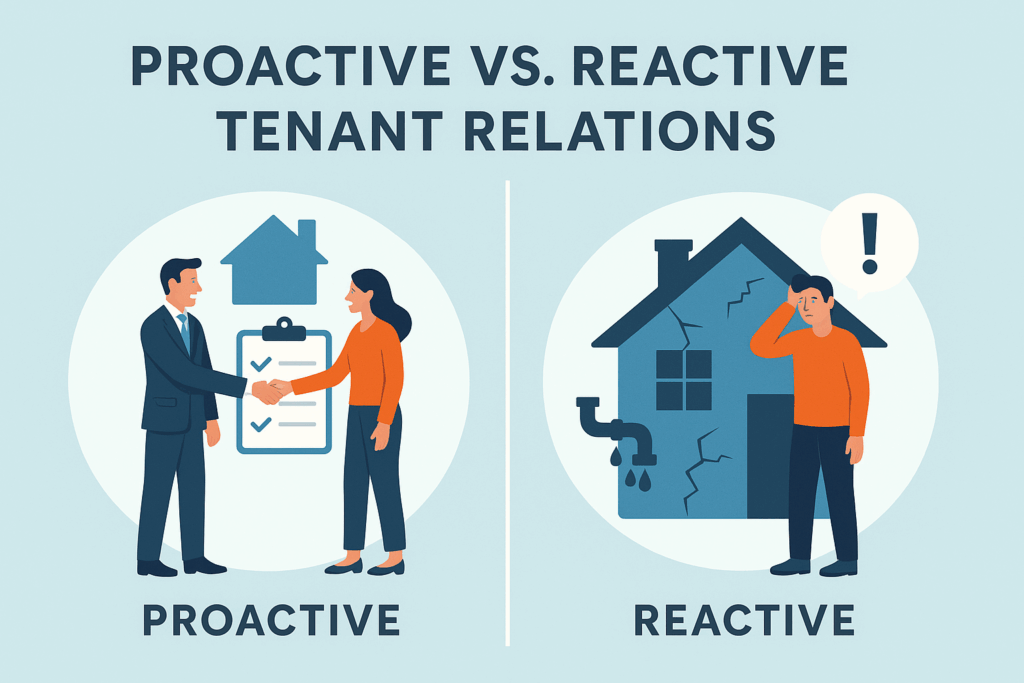
In property management, you’ve probably heard the phrases “proactive” and “reactive” tossed around like buzzwords. But when it comes to tenant relations, the difference between the two isn’t just about how you respond; it’s about the entire experience you create for your tenants.
Let’s break it down with some real-world examples.
Reactive: Fixing Things After They Break
Reactive tenant relations are like putting out little fires. Something goes wrong, a tenant complains, and you fix it.
Say a tenant’s heater stops working during a cold snap. They reach out. You send a technician two days later. Problem solved. But in those two days, they were cold, frustrated, and possibly wondering if they had made the right choice renting from you.
Reactive management waits for a complaint.
The problem? By the time you’re reacting, physical or emotional damage has already happened. Sure, you addressed the issue. But you missed an opportunity to make that tenant feel truly cared for. And over time, that can chip away the trust.
Proactive: Preventing Problems Before They Start
Now picture this: winter is around the corner. You send out an email to all tenants. “Hey! We’ll be checking heaters next week to make sure everything’s running smoothly before the cold hits.” You knock on doors, do inspections, and make small adjustments before anything breaks.
Nobody had to complain.
Nobody had to suffer through a cold night.
They just felt taken care of.
That’s proactive tenant relations.
It’s the little things:
A reminder about the pest control schedule before tenants even notice an issue.
A check-in after a storm: “Hope everything’s okay. Please let us know if you have any leaks.”
Sending out helpful tips about fire safety or how to reset their circuit breaker.
Noticing a tenant’s lease is almost up, and reaching out early to talk about renewal options instead of waiting for them to ask.
It says, “We’re thinking about you before you even have to ask.”
Why This Difference Is a Game-Changer
Let’s be honest, most tenants don’t expect amazing service. They expect to be ignored until something goes wrong. So when you flip the script and show up before problems arise, it sticks.
Proactive management builds loyalty.
Reactive management builds frustration.
And in a world of online reviews, retention challenges, and word-of-mouth referrals, the difference between the two can define your reputation.
Real-World Contrast
Imagine two properties. Same rent. Same location. Almost identical.
At one, tenants only hear from the office when rent is late or there’s a complaint. The fridge breaks, they call, and it takes two days to get it replaced.
On the other hand, they get check-in emails every few months. A welcome packet with FAQs when they move in. A survey after every maintenance visit. And when the fridge stops working, they already know who to contact and how fast the response will be because it was explained from the beginning.
Where would you want to live?
More importantly, where would you stay?
It’s Not About Doing More Work. It’s About Doing the Right Work
Being proactive doesn’t mean micromanaging or babysitting. It means thinking one step ahead and creating systems, automating messages, building trust with your maintenance team, and making tenant comfort part of your standard, not your exception.
It’s sending a birthday card.
It’s walking the property and noticing things before tenants do.
It’s making communication easy, warm, and accessible.
The Bottom Line
Reactive management keeps things running, while Proactive management builds a home. In property management, it’s not just about the physical space; it’s about how we make tenants feel. They may not remember the exact size of their unit, but they’ll remember the quick response when they needed help, the follow-up that showed someone cared, and the moments that made them feel like they truly belonged. That’s what makes the real difference.
